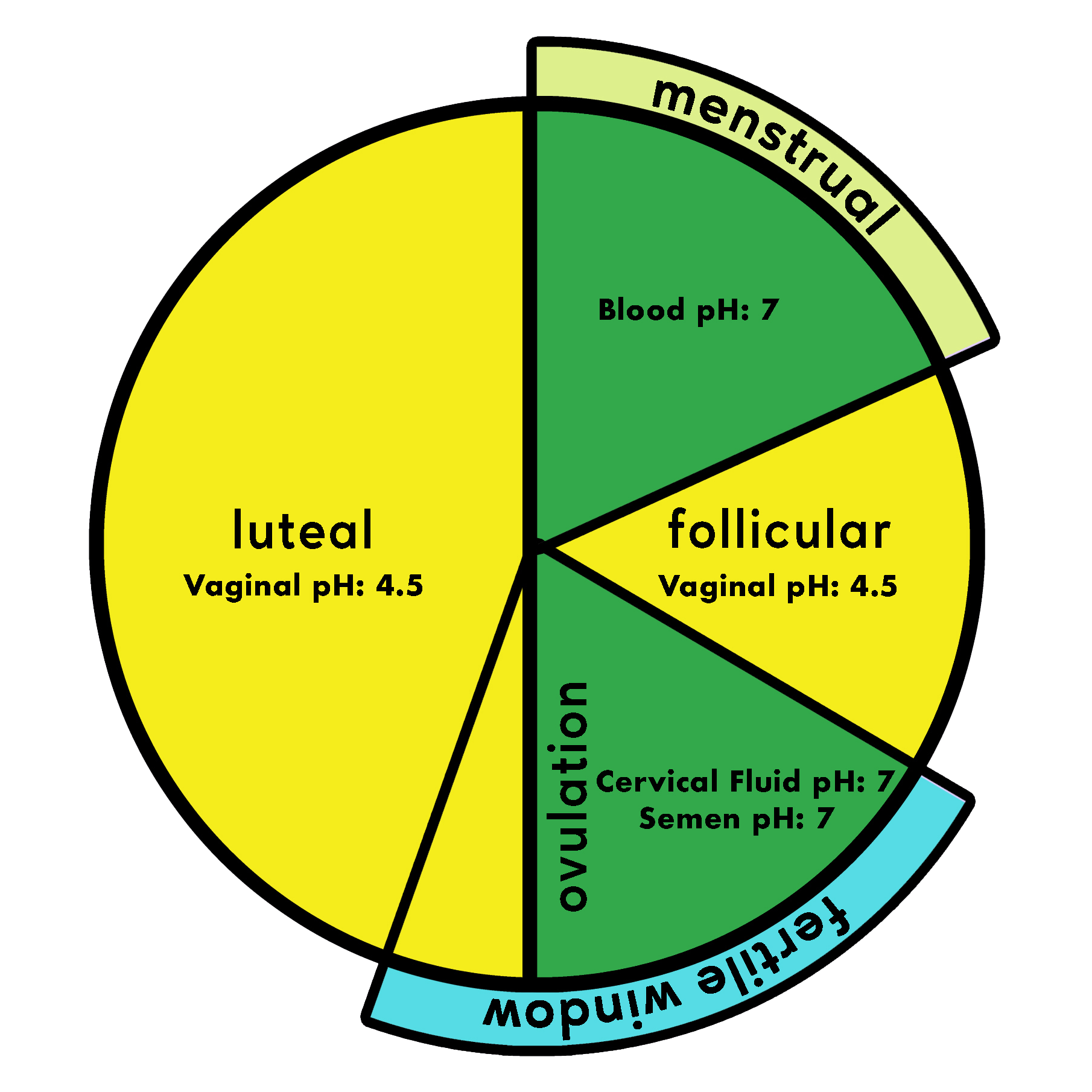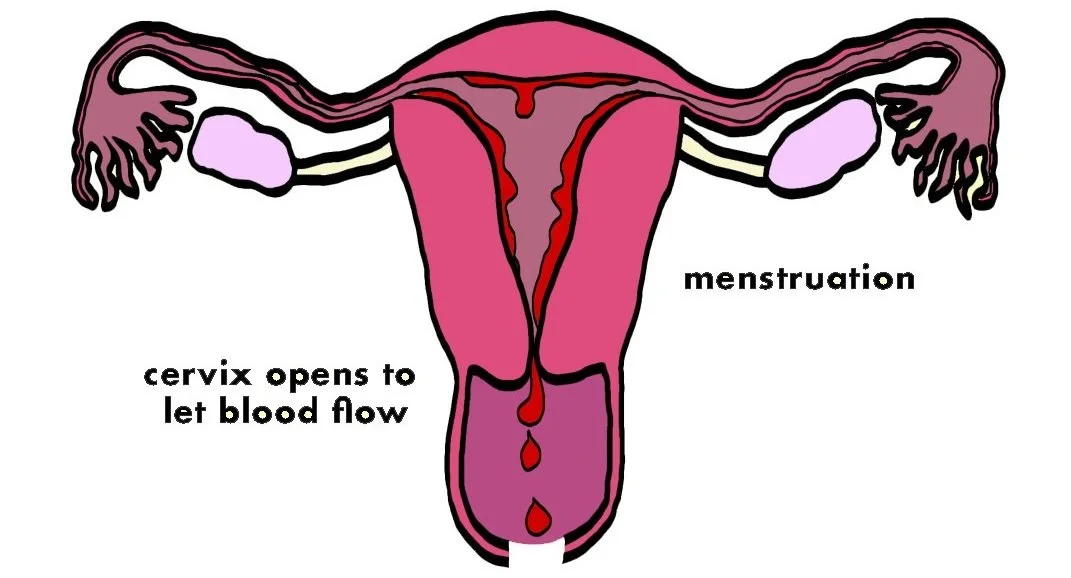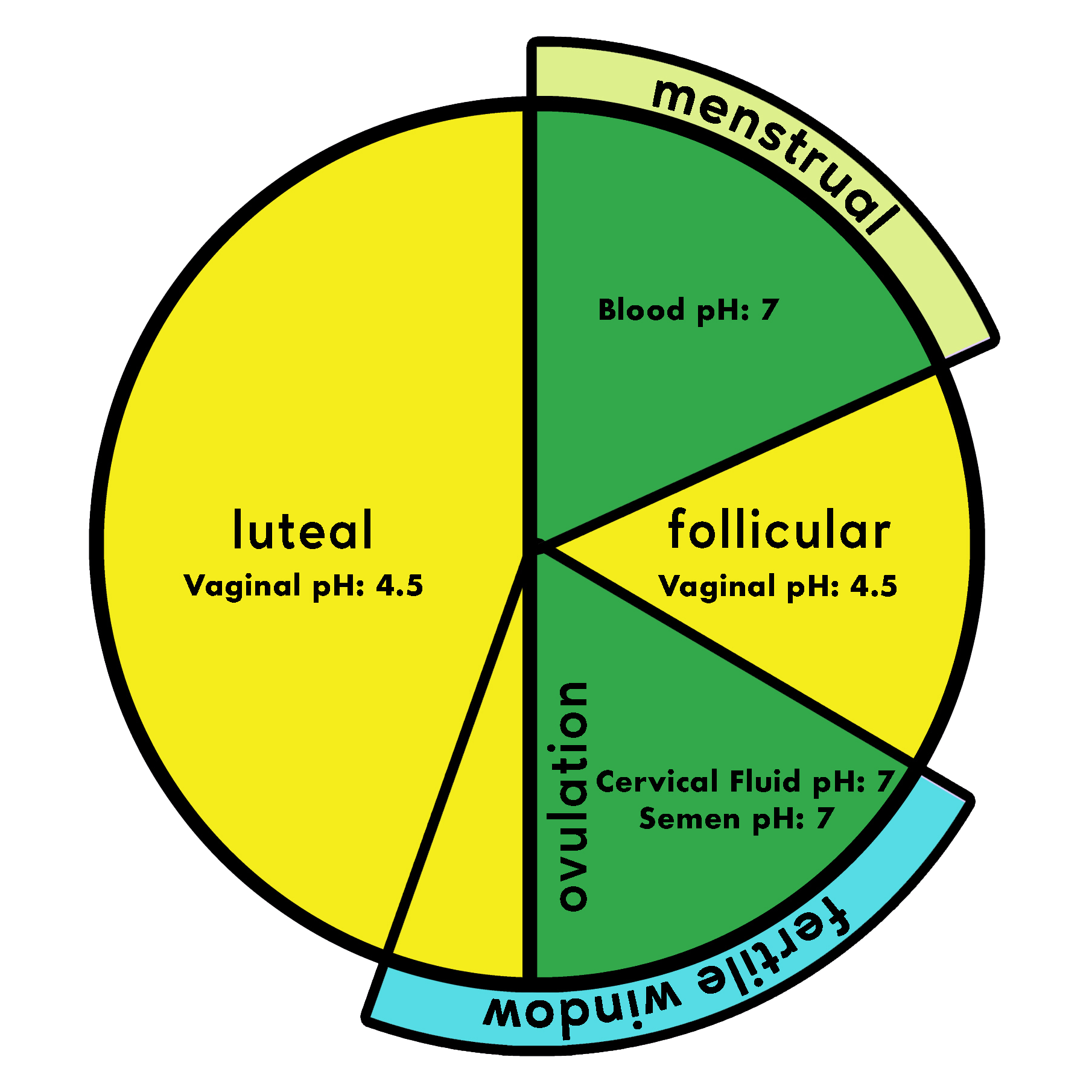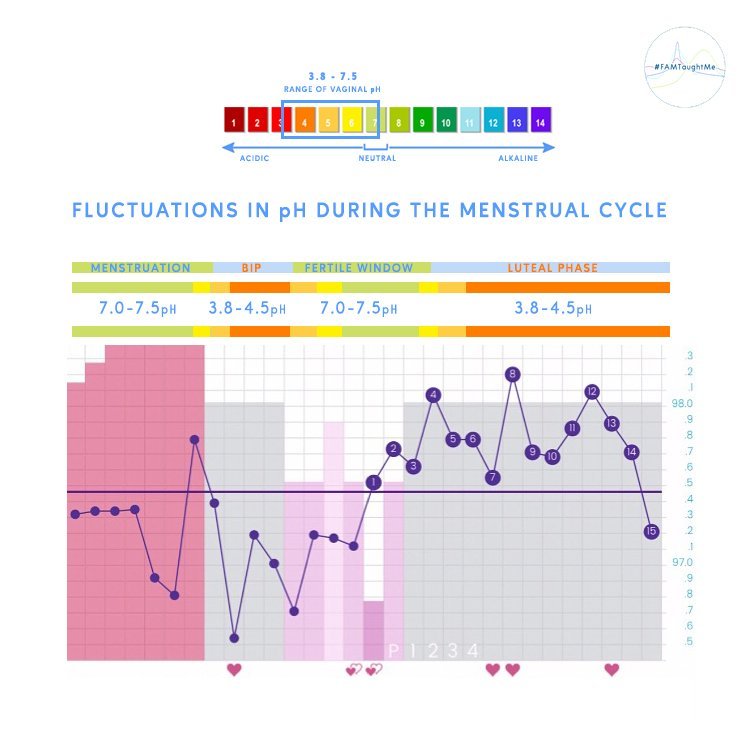Vaginal Health
Our reproductive system is built to create and sustain changing pH levels throughout the cycle.
The pH of the vagina is affected by the normal fluctuation of hormones which release different kinds of cervical fluid.
This fluid, along with the cells in the vagina, contains a microbiome - the vaginal ecosystem - and vaginal balance is characterized by beneficial lactobacillus-dominated microbiota.
These microbes excrete a high concentration of lactic acid produced by the lactobacilli, and this acidifies the vagina, protecting it from harm.
Menstruation
Menstruation: NEUTRAL ~ 7.0 pH - 7.5 pH
During menstruation, the vaginal ecosystem pH is more neutral than usual at around ~7 pH The cervix is open & releases menstrual blood. Blood has a pH of 7.4 which contributes to this temporary state of neutral vaginal pH.
Follicular Phase
Follicular Phase before the Fertile Window (Basic Infertile Pattern): ACIDIC ~ 3.8 pH- 4.5 pH
At the conclusion of menstruation, the vagina returns to its naturally acidic state at around 4.5 pH.
The cervix produces G type cervical mucus which has a high viscosity & forms an impenetrable mucus plug. These cells are part of the immune system, which protect the reproductive system from infection. Because the healthy lactobacilli produce lactic acid, they are able to control the vaginal ecosystem, which prevents infection by fighting off harmful bacteria and yeast.
Ovulatory Phase
Fertile Window & Ovulation: NEUTRAL ~ 7.0 - 7.5 pH Sperm need an alkaline environment to be able to survive more than a couple of hours and swim to fertilize the egg. The body releases fertile cervical mucus to match the pH of semen, ~7-8 pH, during the fertile window and ovulation.
Luteal Phase
Luteal Phase: ACIDIC ~ 3.8 pH - 4.5 pH
After ovulation concludes, estrogen has fallen & progesterone is surging, which causes a rapid decline in the production of fertile quality cervical fluid.
The G crypts are stimulated again, forming the mucus plug which will close the cervix for the rest of the menstrual cycle. The vagina returns to a balance of ~3.8-4.5 pH for the remainder of the cycle.
Imbalance in Vaginal pH
When the vagina becomes dominated by harmful bacteria, they fight to reduce the number of lactobacilli in the vagina. Vaginal microbial diversity is actually not a good thing.
We want lactobacilli to dominate.
When these beneficial lactobacilli microbes cannot make lactic acid, this will cause the vaginal pH to lose acidity & remain more neutral. This creates an environment where even more of the anaerobic bacteria can grow, exacerbating a cycle of chronic vaginal infections.
A pH that stops cycling & is instead regularly or constantly higher than ~4.7 pH is an indication that the vaginal microbiome is disturbed. This elevated pH will also be accompanied by: a foul or fishy smell chunky white, gray, or green discharge vaginal or vulva itching.
Causes of Vaginal Imbalance
-
Yeast infections, trichomoniasis, bacterial vaginosis, aerobic vaginitis, and other conditions cause the vaginal microbiome to be off balance, causing elevated pH levels.
-
Estrogen is the hormone primarily responsible for the changes in cervical fluid which have an effect on the vaginal microbiome & pH level. If you have a deeper underlying issue with cycling of estrogen, this can effect your vagina's ability to self regulate.
-
These drugs don't discriminate which bacteria they kill, so unfortunately your lactobacilli will take a hit when you use antibiotics.Item description
-
Douching wipes out the bacteria in the vagina and has ingredients which are neutral or alkaline. This destroys the microbial protection of lactobacilli while increasing the pH level of the vagina, and creating an environment for harmful bacteria to thrive in.Description text goes here
-
Menstrual blood has a neutral pH of ~7, and when that blood is not allowed to exit, and is instead held in place in the vagina with absorbent products, it creates an environment for these harmful bacteria to live.
-
Semen is neutral to alkaline at around ~7.5 pH, which has the potential to impact the vaginal microbiome. There is an infection or a blockage if semen pH is outside the normal neutral range, which can further tax the vaginal microbiome.
If you and your partner’s vaginal (and groin) microbiome is healthy, and your partner is healthy, you will not have microbiome disruption or a pH imbalance from sex alone.
-
Hormonal birth control shuts down ovulation & therefore you have halted your cycling of estrogen which controls your release of cervical fluid.
When using hormonal contraceptives your vagina will maintain a more neutral to alkaline pH, putting you at greater risk of infection. Copper IUDs also increase the risk of BV.
How can I improve my vaginal health?
Consider that the gut microbiome and the vaginal microbiome are connected.
Heal the gut first. This topic is complex, but consider these options
Increase intake of probiotic foods like ferments, sauerkraut, and kimchi
Avoid food sensitivities that cause inflammation
Avoid pharmaceuticals that can damage the gut like antibiotics, the pill, stomach acid medication, antidepressants
Treat an underlying thyroid problem
Take a digestive enzyme to support stomach acid
Consider probiotic strain Lactobacillus plantarum 299v, or milk thistle
Consider an oral or vaginal dose of the probiotic strains Lactobacillus rhamnosus, GR-1 and Lactobacillus reuteri, RC-14
Avoid feminine wash or douche products, regular soaps inside the vagina, and spermicides or condoms coated in spermicides
Do you have an IUD? IUD’s are known for causing imbalance in the microbiome. The copper IUD doubles the risk of bacterial vaginosis
Sexual partners can contribute to microbiome issues. Have your partner’s follow the same regimen as you.
<< Return to read your bleed
Next to the four phases explained >>
Jump to next section: fertility awareness method >>










